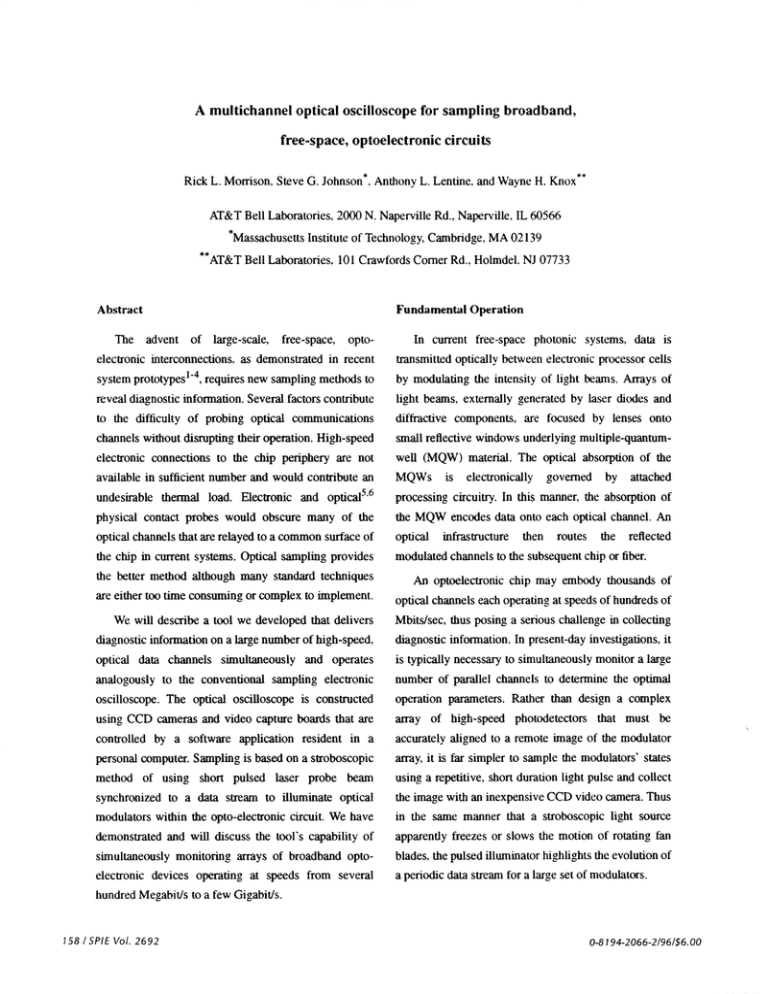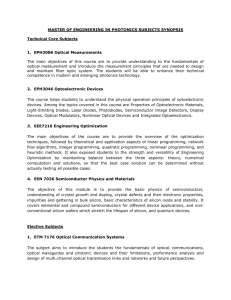A multichannel optical oscilloscope for sampling broadband, freespace, optoelectronic circuits N.
advertisement

A multichannel optical oscilloscope for sampling broadband,
freespace, optoelectronic circuits
Rick L. Morrison, Steve G. Johnson*. Anthony L. Lentine, and Wayne H. Knox**
AT&T Bell Laboratories, 2000 N. Naperville Rd., Naperville, IL 60566
*Massachusetts Institute of Technology, Cambridge, MA 02139
**AT&T Bell Laboratories, 101 Crawfords Corner Rd., Holmdel, NJ 07733
Abstract
Fundamental Operation
The advent of large-scale, free-space, opto-
In current free-space photonic systems, data is
elecironic interconnections, as demonstrated in recent
transmitted optically between electronic processor cells
system prototypes'4, requires new sampling methods to
reveal diagnostic information. Several factors contribute
to the difficulty of probing optical communications
by modulating the intensity of light beams. Arrays of
light beams, externally generated by laser diodes and
diffractive components, are focused by lenses onto
channels without disrupting their operation. High-speed
small reflective windows underlying multiple-quantum-
electronic connections to the chip periphery are not
well (MQW) material. The optical absorption of the
available in sufficient number and would contribute an
MQW5 is electronically governed by attached
undesirable thermal load. Electronic and optical56
physical contact probes would obscure many of the
processing circuitry. In this manner, the absorption of
the MQW encodes data onto each optical channel. An
optical channels that are relayed to a common surface of
optical infrastructure then routes the reflected
modulated channels to the subsequent chip or fiber.
the chip in current systems. Optical sampling provides
the better method although many standard techniques
are either too time consuming or complex to implement.
An optoelectronic chip may embody thousands of
optical channels each operating at speeds of hundreds of
We will describe a tool we developed that delivers
Mbits/sec, thus posing a serious challenge in collecting
diagnostic information on a large number of high-speed,
diagnostic information. In present-day investigations, it
optical data channels simultaneously and operates
analogously to the conventional sampling electronic
oscilloscope. The optical oscilloscope is constructed
is typically necessary to simultaneously monitor a large
number of parallel channels to determine the optimal
using CCD cameras and video capture boards that are
array of high-speed photodetectors that must be
controlled by a software application resident in a
accurately aligned to a remote image of the modulator
personal computer. Sampling is based on a stroboscopic
method of using short pulsed laser probe beam
array, it is far simpler to sample the modulators' states
using a repetitive, short duration light pulse and collect
synchronized to a data stream to illuminate optical
the image with an inexpensive CCD video camera. Thus
modulators within the opto-elecironic circuit. We have
in the same manner that a stroboscopic light source
apparently freezes or slows the motion of rotating fan
demonstrated and will discuss the tool's capability of
simultaneously monitoring arrays of broadband optoelectronic devices operating at speeds from several
operation parameters. Rather than design a complex
blades, the pulsed illuminator highlights the evolution of
a periodic data stream for a large set of modulators.
hundred Megabit/s to a few Gigabit/s.
158 ISPIE Vol. 2692
O-8194-2066-2/96/$6.OO
SYNCHRONIZATION CONTROL
HIGH SPEED
ELECTRONICS
WITH INTEGRATED
MODULATOR ARRAY
Figure 1. Schematic of test photonic system and optical oscilloscope modules.
Tool Design
A schematic of the multichannel, optical
oscilloscope is shown in figure 1. The three primary
functions of the oscilloscope hardware modules are:
•
•
•
integrated since the system to be investigated influences
the design of the probe and synchronization units.
The synchronization control unit is typically custom
designed to match the system. For example, generation
to generate pulses that create short duration readout
of the short-duration readout light pulses can be
light beam arrays for probing the modulator absorplion and to synchronize these pulses with a periodic
performed by connecting new signal lines to the existing
data stream (synchronization control module)
pulsed, broad-area illuminator can be integrated with the
to sample the readout light from several optical data
channels in parallel and focus the individual chan-
optical probe assembly. Since the readout pulse usually
occurs repeatedly during the time sampling window of
nels separately onto a photosensor array, typically a
the photosensor, it must occur at the same point in the
CCD video camera (optical probe unit)
to digitize and analyze the video signal and display
data stream throughout that window. In our
readout lasers in some systems, while in other cases a
the sampled waveforms in a format similar to that
demonstrations, we have maintained synchronization by
using coupled data and pulse generators referenced to a
of an oscilloscope (analysis and display processor)
common clock, but differing by about 1Hz at the bit
Currently, the separate modules have been only loosely
frequency so that the pulse slowly scans the data pattern.
SPIE Vol. 2692 / 159
It is also possible to use a delay generator to scan the
readout pulse through the data steam. although this
would require control signals from the analysis unit to
signal convertor. The temporal resolution is effected by
coordinate the process. The end result is that a multitude
the width of readout pulse and the speed with which it
of samples are collected from a finite duration window
scans through the data stream. The tool has proven
of the data stream by a low speed photodetector.
capable of analyzing as many as 256
intensity resolution of the waveform is limited by video
noise and the digitization accuracy of the A/D video
channels
The optical probe, also referred to as the viewport.
simultaneously without any degradation in performance.
extracts light from the system using a partially reflecting
surface, such as a beam-splitter or pellicle. The deflector
must be designed so that it does not seriously disturb the
One further advantage of collecting the data using a
video camera is that the video signal can be recorded
using video tape recorders. Thus. the performance can
readout beams or other optical channels communicating
be archived and reanalyzed at a later time.
information to the optoelectronic chip. The optical
channels of systems we investigated operated at a
wavelength of 850 urn which is within the sensitivity
range of most CCD cameras. Filters are used to reduce
the intensity level as necessary. Lenses form an
appropriately sized image of the optoelectronic
modulator array on the video camera. At this point, the
user is able to watch the evolving intensity variation of
the spots on a video monitor.
The analysis and display processor must digitize and
store the video signal frame-by-frame. Enhanced
multimedia computers are available with internal video
cards that provide accessibility of the video memory to
the processor. We have developed a custom written
software application to coordinate the analysis, control,
and display interface for the oscilloscope. Our
implementation of the oscilloscope was produced for an
Apple Macintosh 840AV and demonstrated on other
compatible Macintosh platforms.
The location and sizes of the regions of interest (i.e.,
the modulator spots) are interactively defined by the
user while examining either a live or captured video
frame. During operation, the processor calculates the
average intensity in a set of predetermined regions of
Figure 2.
Readout light beams illuminating high-
speed MQW modulator array.
interest and plots these intensities in a variety of
possible waveform formats. Control of other display
aspects, such as the scales of the intensity and time axis,
are also provided to the user. In operation. our system
collected and analyzed about 10 video frames/sec. The
160/SPIE Vol. 2692
High-speed system demonstration
To demonstrate the high-speed capability of the
optical
oscilloscope, an array of independent.
electrically driven, differential multiple quantum well
modulators7 were monitored while operating at multi-
oscilloscope performance is attained when the spots are
Gbitls speeds. The sixteen modulator windows are
defocused to illuminate a larger area.
shown with their associated readout beams in figure 2.
Freespace photonic switch fabric
The synchronization between the data stream and
probe pulses were fixed by using two high-precision,
frequency stabilized analog signal generators
synchronized to a common clock to trigger digital data
To demonstrate its operation in a practical system,
the multichannel optical oscilloscope was used to
examine the performance of the current free-space
and pulse generators. The optical probe pulse was
photonic switching demonstration4. This demonstration
measured to have a width of about 200 ps as measured
system is composed of one opto-electronic chip
comprising sixteen independent 16x16 crossbar
by an independent high-speed detector.
Two independent NRZ data waveforms and their
complements were connected to four of the eight
modulator pairs while a square waveform was
connected to the remaining four pairs. Figure 3 shows
the oscilloscope iraces for data streams of 1 Gbitsls and
—
square waves of 1GHz. All traces share a common time
E
[
r
-wI
WNWAWPMNWW.
LffrJ\J
£
{
switches, and the optomechanical infrastructure to relay
optical channels between the chip and a twodimensional fiber bundle array. The opto-electronic chip
is a hybrid combination of GaAs MQW modulators
bonded to VLSI silicon processing circuitry and
illustrates the potential for dramatically expanding data
throughput. The fiber bundle serves to collect and
concentrate the data streams for remote external
transmitters and receivers. In addition, a small number
of low-speed electronic connections supply control and
switch configuration information to the chip. During
operation, the switching fabric has been shown to route
njLnLJr\
digitized video and ATM-like traffic.
—-----------,--
was examined. Two independent optical input channels
[
provided periodic 8-bit data streams for this node. The
[
I
I
In this demonstration, one 16x16 switching node
switch was configured to route each of the two input
streams to separate output modulators. The system was
operated at a channel data rate of 200 Mbits/s which,
under normal operation, provides sufficient overhead to
allow switch reconfiguration and data encoding and a
net communications channel throughput of 155 Mbits/s.
Figure 3. Optical oscilloscope traces from high-speed
modulators for lGbitls data and 1GHz square waves.
The photonic switch required only minor
adjustments to enable the oscilloscope to monitor
and intensity scale. The reduced intensity variation in
operations. A low reflectivity fused silica substrate, that
certain channels is due to local heating, caused by
was also used for inspecting optical beam registration,
tennination of transmission lines, that shifts the
was inserted near the system pupil to deflect a portion of
operating characteristics of the modulator. Although the
beams are well focused on the modulator windows in
the modulated light toward a video camera. Lenses and
attenuators were then selected to produce an image of
this test, we have demonstrated that equivalent
the 16 output modulators residing on the surface of the
SPIE Vol. 2692 / 161
Wj1
ri w r
nw ;jv Jv
Figure 4.
M
Fifteen traces obtained simultaneously from free-space photonic switch operating at a channel rate of
200 Mbits/sec. One of two separate input data channels is routed to each output modulator.
optoelectronic chip. This viewport assembly did not
disrupt system operation as evidenced by the
undisturbed routing of a separate video data stream.
system demonstration.
During the diagnostics test, the multichannel
In order to coordinate the data and readout signals, a
oscilloscope provided the opportunity to investigate the
full set of output channels that was inaccessible with the
common reference clock synchronized a data generator
current, sparsely populated output fibers. In addition, it
and pulse generator operating at 200,000.001 Hz and
25 MHz respectively. The data generator, a Tektronix
was possible to immediately discern the differing
HFS9000 stimulus generator, is part of the system
function of the bias voltage.
hardware. The readout laser, usually operated as a CW
source, was modulated by the 25 MHz signal with a
Summary
pulse width of about 1 ns. Thus a series of eight data bits
were scanned over a time interval of about 8 seconds.
operating characteristics of the receiver designs as a
Ongoing development of new opto-electronic
interconnection architectures and technologies requires
Figure 4 shows oscilloscope traces that were
the invention of new diagnostic tools to investigate the
obtained simultaneously from the active system. Only
fifteen traces are displayed since only 15 of the 16
performance of these novel photonic circuits. The
application of stroboscope techniques using
output modulators were illuminated by readout beams.
commercially available CCD cameras to probe optical
This scheme is due to a design experiment where two
alternate receiver designs, optimized for different power
absorption characteristics of modulator-based systems
levels, were tested. The optimal configuration required
shifting all spot arrays by one location so that the
sparsely populated fiber array was aligned with the
better performing circuitry leading to a more robust
162 /SP!E Vol. 2692
provides the basis for our high-speed, multi-channel,
optical oscilloscope. We have demonstrated its
capabilities by collecting diagnostics from parallel
multi-Gbits/s data streams and from practical free-space
photonic prototype systems.
Acknowledgments
This work was partially sponsored by the Advanced
Research Project Agency under the U.S. Air Force
Rome Laboratory contract number F30602-93-C-O 166.
J. Quant. Elect.. QE-22. 69-78 (1986).
6. B. H. Kolner and D. M. Bloom. "Electrooptic
sampling in GaAs
Elect..
integrated circuits." J. Quant.
QE-22. 79-94 (1986).
7. A. L. Lentine. L. M. F. Chirovsky, L. A. D'Asaro, R.
References
1.
F. B. McCormick, T. J. Cloonan, F. A. P. Tooley, A.
L. Lentine, J. M. Sasian, J. L. Brubaker, R. L.
F. Kopf. and J. M. Kuo, "High speed 2x4 array of
differential
quantum well modulators," Phot. Tech.
Leti 2. no. 7. 477-480(1990).
Morrison, S. L. Walker. R. J. Crisci, R. A. Novotny,
S. J. Hinterlong, H. S. Hinton, E. Kerbis, "Six-stage
digital free-space optical switching network using
symmetric seif-electro-optic-effect devices," Appi.
Opt. 32, no. 26, 5153-5171 (1993).
2. F. B. McCormick, T. J. Cloonan, A. L. Lentine, J.
M. Sasian. R. L. Morrison, M. G. Beckman, S. L.
Walker, M. J. Wojcik, S. J. Hinterlong, R. J. Crisci,
R. A. Novotny, H. S. Hinton, "Five-stage free-space
optical switching network with field-effect
transistor self-electro-optic effect-device smart-
pixel arrays" Appl. Optics 33, no. 8, 1601-1618
(1994).
3. F. B. McConnick, A. L. Lentine, R. L. Morrison, J.
M. Sasian. T. J. Cloonan, R. A. Novotny, M. G.
Beckman, M. J. Wojcik, S. J. Hinterlong, and D. B.
Buchholz, "155 Mb/s operation of a VET-SEED
free-space switching network," Photon. Tech. Lett.
6, no. 12, 1479-1481 (1994).
4.
A.L. Lentine, DJ. Reiley, R.A. Novotny, R.L.
Morrison, J.M. Sasian, M.G. Beckman. D.B.
Buchholz, S.J. Hinterlong, T.J. Cloonan, G.W.
Richards, and F.B. McCormick, "Optoelectronic
ATM switch employing hybrid silicon CMOS!
GaAs FET-SEEDs", SPIE Proceedings conference
#2692, 1996.
5.
J. A. Vaidmanis and G. Mourou, "Subpicosecond
electrooptic sampling: principles and appIications,
SPIE Vol. 26921163






